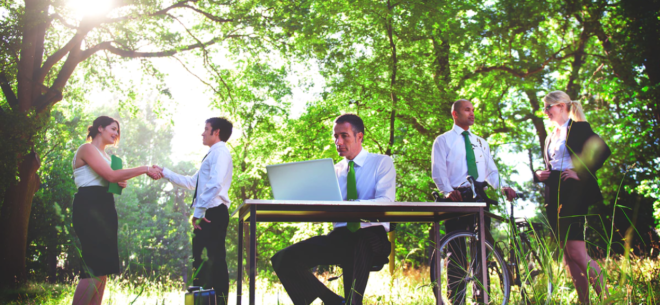
Green Buildings: The Next Big Thing in Office Design
When it comes to “going green,” what often comes to mind are individual decisions such as recycling and replacing old incandescent lightbulbs.
But increasingly, business owners are working green elements into their plans as they lay out their dream offices. In fact, a survey of 200 Australian business leaders found that four out of five aimed to be more sustainable.
This is just good business: Making your office building as green as possible works both boosts your bottom line (as these decisions generally save money in the long run) and, of course, work from an environmental friendliness standpoint.
So, here are a few ways that businesses are making green buildings the next big thing in office design.
Recycle, reuse, repurpose
In the office especially, empowering and encouraging the recycling and reuse of resources goes a long way in terms of reducing emissions.
Locally sourced and recycled paper products are a must for any office looking to go green. On average, Australians use approximately 230kg of paper per person every year – meaning where that paper comes from and how it’s disposed of are crucial factors in making an office greener.
For any paper waste, recycle bins should be readily accessible. Rather than focusing on the placement of trash bins around the office, make sure that recycling areas are the priority.
Beyond paper, make sure that water fountains and coolers include enough space for refilling reusable bottles and containers as alternatives to disposable plastic water bottles. Stock reusable cups instead of disposable ones.
Successful recycling and reuse programs are as much about enabling employees as they are about encouraging them – and smart green design helps do just that.
Design flexible spaces
“Reuse” in green design is about much more than bottles and recycled paper – it’s about furniture and space, as well.
If your office is full of areas and rooms that can only be used for a single purpose, and furniture that’s limited in its flexibility, it could probably use a green redesign.
Many savvy business owners are reimagining their offices such that different spaces can pull double or even triple duty.
Adjustable desks, chairs, and other furniture can accommodate many different employees, while things like dividers and modular furniture allow rooms or areas to be completely rearranged depending on the business’s needs that day.
These and other kinds of furniture can be found at Office Products Depot and other major office suppliers.
Designing with multifunctionality in mind support a more efficient – and green – office.
Incorporate natural lighting

Image source: Pexels
Lighting is the most constant draw on energy resources in the office, as sufficient light is always needed to get work done.
And while swapping out older fixtures and lightbulbs for more efficient models can help, an even greener move is to design the office around available natural light.
Making workspaces more open can allow in more natural light. In designing a green office space, it’s important to pay attention to where the largest windows are – and put important areas such as workspaces and meeting rooms nearby.
If possible, adding large skylights can help bring more natural light to areas that don’t normally get much of it.
Keep things insulated
It often falls under the radar, but one of the biggest drains on resources in an office is temperature control. Nowadays, when a metal building contractor erects a building, they can implement innovative technology to help conserve resources, but for older buildings, it can be harder to regulate.
Air conditioning and heating expenses can soar depending on weather patterns, and those expenses account for a large portion of the 30 percent of energy costs that the average commercial building wastes. Shoring up your office’s insulation can help cut these costs.
This carries some upfront investment, but insulation quickly pays for itself with every hour it saves in terms of heating and cooling, passively regulating the temperature.
Another smart move: Installing multiple thermostats throughout the office, ensuring that temperature control goes where it needs to – and stays off where it’s unnecessary.
Getting smart about climate control in the office is a great way to make the whole building greener.
Reduce water waste
Residential designers understand the importance of water efficiency, but this is an important factor to consider in office design as well.
While folks generally aren’t showering at the office, they’re still using water, whether they’re washing their hands, using the toilet, or even cleaning dishes in the office kitchen.
To conserve water, touch or push taps can be ideal, while for areas with more continuous water usage (such as the kitchen tap), low-flow fixtures should be considered.
Water-efficient toilets and urinals make a great deal of difference in terms of water efficiency as well.
Going green in the world of office design means thinking about every resource, top to bottom – and there’s nothing more fundamental than water.
Conclusion
Green buildings are an up-and-coming trend in office design, and for very good reason.
A green office helps forward-thinking businesses reduce their negative impact on the environment, improve the company’s image, and save money over the years.
Incorporating environmental friendliness into the design process makes the commitment to a green office fundamental – and everyone working in the office will be empowered to do their share in terms of reducing emissions.
[ssba]
